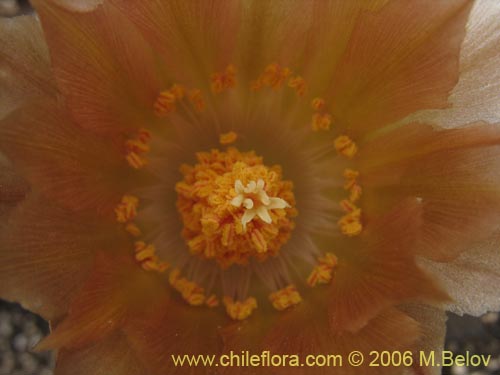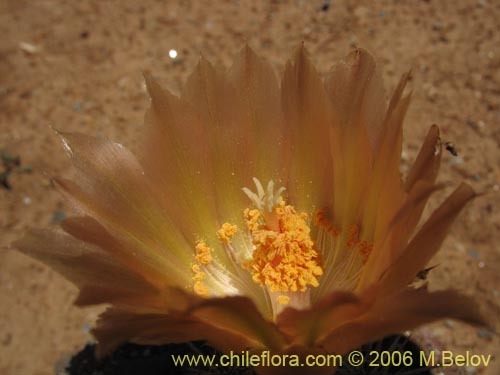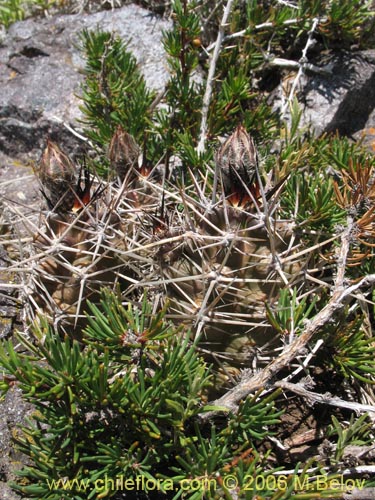|
|

Austrocactus philippii的照片
地方:VII Region, Pelarco, Libueno, 智利
海拔:300 米. 24日12月2006年
|
|
|
這頁您用别的语言可以看: |
| 种: | Austrocactus philippii (Regel & C.E. Schmidt) Buxbaum | |
| 科: | Cactaceae, 仙人掌科 | |
| 目: | Caryophyllales | |
| 智利白話名: | Hiberno | |
| 英文名: | ||
| 德文名: | ||
| 俄文名: | ||
| 紀錄: | 0673 |
在智利 属于Austrocactus 属的种一共有差不多 3种 。 |
|
在智利属于Cactaceae, 仙人掌科的种一共有差不多 164 种。 |
  |
|
|
|
|
| 智利固有的植物 非常稀少的植物
植物高: 15 cm. 漂亮的植物 (观赏性:A) |
介绍This is one of the most rare and amazing plants in Chile. Only two locations are known where it can be found, and the last location was discovered just recently by the University of Talca. It seems that the first location was plundered, because there were no reports of seeing it there lately. So the newly discovered location may be the only one where it is known to be. On the other hand, this cactus is so well camouflaged that it is very difficult to spot; so, unless you sit on top of it, you may never discover that it is there. Finding new locations are therefore extremely difficult. Only when it is blooming there is a real chance of finding it. This cactus, apart from being one of the rarest, is also one which is most cold-resistant.
|
Austrocactus philippii的照片 地方:VII Region, Pelarco, Libueno, 智利
|
植物描写
植物形: 灌木 花: 黄色,花瓣 七-十四张 植物高: 15 cm.
It forms groups of about 6 - 12 plants; it has a columnar body, with somewhat soft, green tissue, generally short, erect stems about 5 - 20 cm. long and about 3 - 4 cm. in diameter, some stems may also be prostrate. It has 7 or 8 prominent ribs, 6-8 marginal thorns, and 3 - 4 central thorns of up to 3 cm. long. The flowers are about 5 cm. long, yellow-orange-brown, and the blooming season is from the end of December through January. |
Austrocactus philippii的照片 地方:VII Region, El Melado, 智利
|
分布区
按照海拔的分布区: 高的海拔 (在森林之上)
浇水条件: 有一些干燥,干旱的区域。 天旱期间大概持续三个到五个月。 400-800 毫米的雨 在冬天集中。
阳光条件: 直射的太阳光。 没有保护的地方。比如说,没有树的平坦的地房,或者向北方的斜面。
It lives just in one specific location in the 7th Region, at an altitude of 2000 m. (location 1) and 2200 m (location 2). It seems to prefer flat, but rocky areas, exposed to sun. The soil where the roots are growing has a considerable organic matter concentration, despite the fact that the superficial soil around is rather barren. It forms a community with Mulinum spinosum, Ephedra chilensis and Berberis empetrifolia. Despite the fact that it grows in a very open location, its light requirements are probably average, because in summer due to thunderstorms it would get direct sunlight only in the mornings (for about 5 - 6 hours); in the afternoon it is protected by clouds. The temperature regime in summer is: max. 20º C (at noon), min. 0º C (at dawn), with occasional freezing temperatures possible. In winter, the temperature would oscillate around -5º under snow cover, with a range of -15º - 0º.
|
Austrocactus philippii的照片 地方:VII Region, El Melado, 智利
|
使用可能漂亮的植物 (观赏性:A)
As of now, it does not have any known uses, but it certainly can be ornamental. As such, it has a very strong potential, because it can be easily grown outdoors in rather cold climates, like Central Europe - its ability to withstand snow for 3 to 4 months and freezing temperatures of up to - 15º C makes it unique among the cacti. |
Austrocactus philippii的照片 地方:VII Region, El Melado, 智利
|
植物栽培注意对寒冷的气候来说这个植物忍耐性非常高。植物可以忍耐很低的零下温度(零下至少12°C - 15°C, 也许到20°C下)。 在很多月内(一个月到八个月)这个植物可以忍耐雪蓋子。USDA气候带 7, 6b。
No information is available so far; however, it seems that exposing it to high temperatures will definitivly kill it, so for warm and hot climates with over 25º C a plausible alternative would be to provide forced cooling during the hot period. Another alternative for the countries with hot summer season would be to hibernate it in refrigerator (this should be almost certainly Ok, because in nature it is covered by snow for about 4 months with no light at all) during the summer time and use the spring/winter/autumn for vegetative growth. 如果你想买这杨的植物种子,请您就在这儿离继续看. |
|
Austrocactus philippii (Regel & C.E. Schmidt) Buxbaum 植物更多的照片這里可以看.
|




